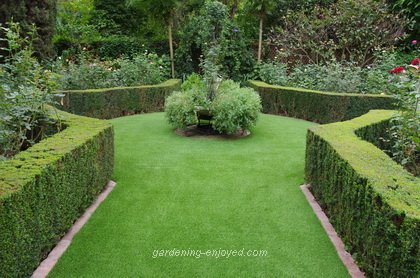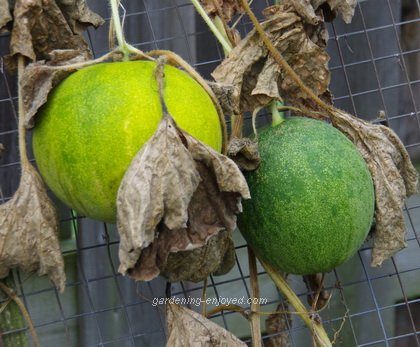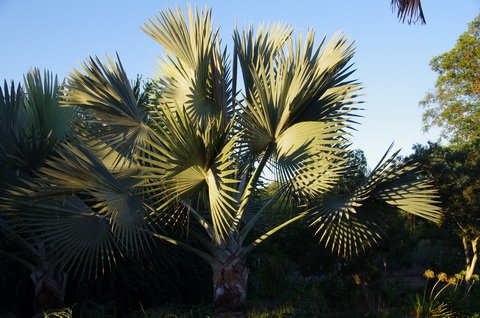| Back to Back Issues Page |
 |
|
Dallying In The Dirt, Issue #234--- My Palm fantasies were given a wonderful boost this week. September 25, 2015 |
 Most of California is in a long drought and observing their many ways of dealing with it was quite interesting. They tend to conserve their ration of water for the things that are very important to them and then adjust their planting plans to include more drought tolerant plants. They, like many of us, prize a bright green lawn but are discovering just how water intensive such things are. The picture is from one of the private gardens that we visited. A great group of Roses that need water surrounded by some lovely Myrtle hedges that survive on any excess their neighbouring Roses get and then the lovely green pathways between done in what we call Lawnis plasticus. They had another section of their back yard in artificial grass, that they assured us, was Grandchild tested and approved as a play area. I suspect that the plastic grass industry is going to be a growth, (pun intended,) industry in that part of the world. The amount of infrastructure, pipes, valves,
solenoids and sprinkler heads that were in some gardens was quite amazing and a significant dollar investment that allowed them to move an incredible amount of water in a short time. Their water restrictions seemed to be on, time spent watering, not on volume used. Made my hose and watering can seem rather obsolete.
Most of California is in a long drought and observing their many ways of dealing with it was quite interesting. They tend to conserve their ration of water for the things that are very important to them and then adjust their planting plans to include more drought tolerant plants. They, like many of us, prize a bright green lawn but are discovering just how water intensive such things are. The picture is from one of the private gardens that we visited. A great group of Roses that need water surrounded by some lovely Myrtle hedges that survive on any excess their neighbouring Roses get and then the lovely green pathways between done in what we call Lawnis plasticus. They had another section of their back yard in artificial grass, that they assured us, was Grandchild tested and approved as a play area. I suspect that the plastic grass industry is going to be a growth, (pun intended,) industry in that part of the world. The amount of infrastructure, pipes, valves,
solenoids and sprinkler heads that were in some gardens was quite amazing and a significant dollar investment that allowed them to move an incredible amount of water in a short time. Their water restrictions seemed to be on, time spent watering, not on volume used. Made my hose and watering can seem rather obsolete. When I finally returned to my own little garden paradise there were many things to discover. Surprise, the weeds had grown quite nicely. The Assistant Gardener had all of the containers in great condition and realizing just how much time it takes, she allowed as how she thinks I should look at some drip irrigation system to reduce all of that labour. She’s right, of course. I’ll remember some of the sophisticated systems I saw last week and start this winter’s planning activity. In the very back of the yard there are some wire frames leaning against the back fence and hanging on to them were these lovely melons. Had one with my toast for breakfast this morning and it was sweet, juicy and delightful. Melons are not very productive but their vines do cover a lot of territory and that’s why they get trained up these wire frames. It also keeps the fruit off the ground reducing the slug damage and the yellow rotting
spot where they are in contact with the soil. All part of the Vertical Vegetables program that helps me produce the maximum yield from a small back yard garden.
When I finally returned to my own little garden paradise there were many things to discover. Surprise, the weeds had grown quite nicely. The Assistant Gardener had all of the containers in great condition and realizing just how much time it takes, she allowed as how she thinks I should look at some drip irrigation system to reduce all of that labour. She’s right, of course. I’ll remember some of the sophisticated systems I saw last week and start this winter’s planning activity. In the very back of the yard there are some wire frames leaning against the back fence and hanging on to them were these lovely melons. Had one with my toast for breakfast this morning and it was sweet, juicy and delightful. Melons are not very productive but their vines do cover a lot of territory and that’s why they get trained up these wire frames. It also keeps the fruit off the ground reducing the slug damage and the yellow rotting
spot where they are in contact with the soil. All part of the Vertical Vegetables program that helps me produce the maximum yield from a small back yard garden. Now it’s time to answer a few of my reader’s questions. Don’t forget to check the front page of the Website for frequent short ideas for current gardening activities. Dan Asks? 1. With autumn only a couple of days away. What type of fall fertilizer would you recommend for my lawn?
2. Last summer I added a Pinky Winkie Hydrangea tree to my front landscape. The November storm all but destroyed the tree. The spent blooms were still on the tree. The weight of the snow snapped all but two of the branches. In the spring I transplanted the tree into a pot and put it on my patio. The tree made a remarkable recovery, I just replanted it. Now to my question! How do I prune the tree? Do I remove the spent blooms or
wait until spring? |
| Back to Back Issues Page |
